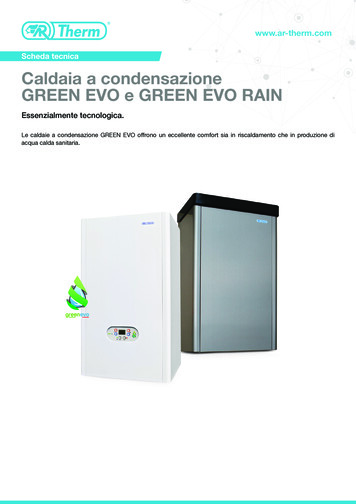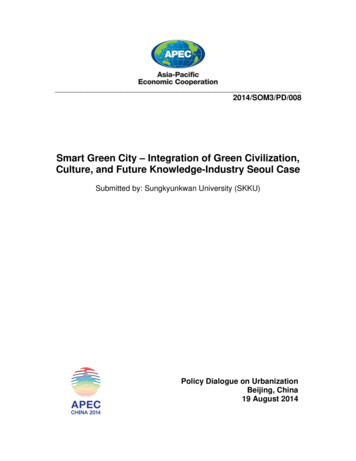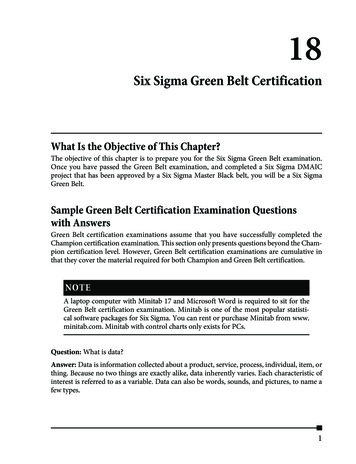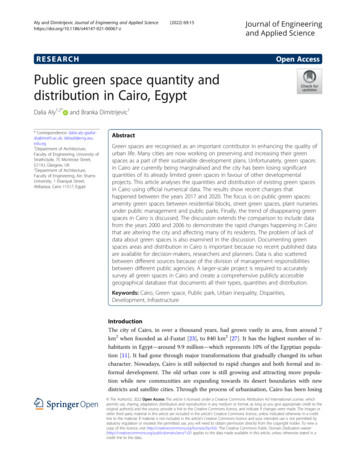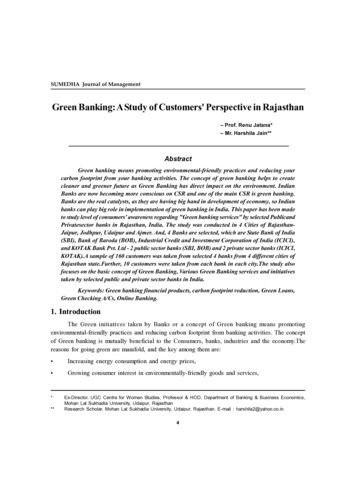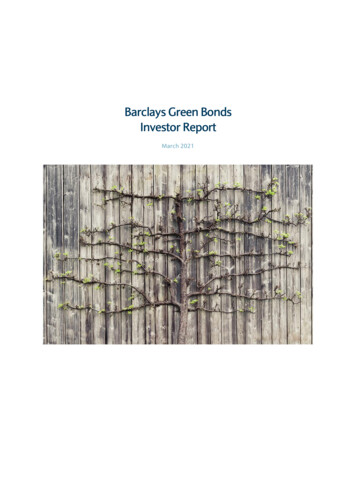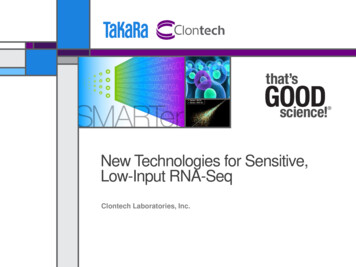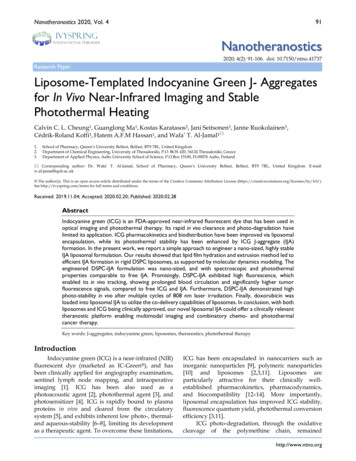
Transcription
Nanotheranostics 2020, Vol. 4IvyspringInternational Publisher91Nanotheranostics2020; 4(2): 91-106. doi: 10.7150/ntno.41737Research PaperLiposome-Templated Indocyanine Green J- Aggregatesfor In Vivo Near-Infrared Imaging and StablePhotothermal HeatingCalvin C. L. Cheung1, Guanglong Ma1, Kostas Karatasos2, Jani Seitsonen3, Janne Ruokolainen3,Cédrik-Roland Koffi1, Hatem A.F.M Hassan1, and Wafa’ T. Al-Jamal1 1.2.3.School of Pharmacy, Queen’s University Belfast, Belfast, BT9 7BL, United KingdomDepartment of Chemical Engineering, University of Thessaloniki, P.O. BOX 420, 54124 Thessaloniki, GreeceDepartment of Applied Physics, Aalto University School of Science, P.O.Box 15100, FI-00076 Aalto, Finland Corresponding author: Dr. Wafa’ T. Al-Jamal, School of Pharmacy, Queen’s University Belfast, Belfast, BT9 7BL, United Kingdom. E-mail:w.al-jamal@qub.ac.uk The author(s). This is an open access article distributed under the terms of the Creative Commons Attribution License (https://creativecommons.org/licenses/by/4.0/).See http://ivyspring.com/terms for full terms and conditions.Received: 2019.11.04; Accepted: 2020.02.20; Published: 2020.02.28AbstractIndocyanine green (ICG) is an FDA-approved near-infrared fluorescent dye that has been used inoptical imaging and photothermal therapy. Its rapid in vivo clearance and photo-degradation havelimited its application. ICG pharmacokinetics and biodistribution have been improved via liposomalencapsulation, while its photothermal stability has been enhanced by ICG J-aggregate (IJA)formation. In the present work, we report a simple approach to engineer a nano-sized, highly stableIJA liposomal formulation. Our results showed that lipid film hydration and extrusion method led toefficient IJA formation in rigid DSPC liposomes, as supported by molecular dynamics modeling. Theengineered DSPC-IJA formulation was nano-sized, and with spectroscopic and photothermalproperties comparable to free IJA. Promisingly, DSPC-IJA exhibited high fluorescence, whichenabled its in vivo tracking, showing prolonged blood circulation and significantly higher tumorfluorescence signals, compared to free ICG and IJA. Furthermore, DSPC-IJA demonstrated highphoto-stability in vivo after multiple cycles of 808 nm laser irradiation. Finally, doxorubicin wasloaded into liposomal IJA to utilize the co-delivery capabilities of liposomes. In conclusion, with bothliposomes and ICG being clinically approved, our novel liposomal IJA could offer a clinically relevanttheranostic platform enabling multimodal imaging and combinatory chemo- and photothermalcancer therapy.Key words: J-aggregates, indocyanine green, liposomes, theranostics, photothermal therapyIntroductionIndocyanine green (ICG) is a near-infrared (NIR)fluorescent dye (marketed as IC-Green ), and hasbeen clinically applied for angiography examination,sentinel lymph node mapping, and intraoperativeimaging [1]. ICG has been also used as aphotoacoustic agent [2], photothermal agent [3], andphotosensitizer [4]. ICG is rapidly bound to plasmaproteins in vivo and cleared from the circulatorysystem [5], and exhibits inherent low photo-, thermaland aqueous-stability [6–8], limiting its developmentas a therapeutic agent. To overcome these limitations,ICG has been encapsulated in nanocarriers such asinorganic nanoparticles [9], polymeric nanoparticles[10] and liposomes [2,3,11]. Liposomes areparticularly attractive for their clinically wellestablished pharmacokinetics, pharmacodynamics,and biocompatibility [12–14]. More importantly,liposomal encapsulation has improved ICG stability,fluorescence quantum yield, photothermal conversionefficiency [3,11].ICG photo-degradation, through the oxidativecleavage of the polymethine chain, remainedhttp://www.ntno.org
Nanotheranostics 2020, Vol. 4unavoidable unless chemical modifications are made[15]. Unfortunately, ICG rapid photo-degradationupon irradiation hampers its development as anefficient photothermal agent [3,16]. J-aggregatesformation is an alternative approach to improve ICGoverall stability [17,18]. In 1936, E. E. Jelley (hence theletter J in J-aggregate) discovered the existence ofnematic (almost parallel) aggregates of the dyepseudoisocyanine chloride, exhibiting distinctivespectroscopic properties [19]. J-aggregates arecharacterized by absorption spectra with a verynarrow width (10 – 20 nm), dramatic redshift ( 100nm), and strongly increased molar attenuationcoefficient, in comparison with their monomers. Theirfluorescence emission spectra are also redshifted andsharpened, with a dramatic reduction in radiativelifetime, termed “superradiance” [17,18]. As a copically active in the NIR region, allowingbioimaging with minimal auto-fluorescence frombiological tissues, reduced light scattering, and highertissue penetration [18]. ICG J-aggregate (IJA), firstreported more than 50 years ago, demonstratedexceptional photo-, thermal-, and aqueous-stabilitycompared to monomeric ICG [6,20]. Encouragingly,Liu et al. recently reported IJA as a theranostic agentenabling both fluorescence/optoacoustic imaging andphotothermal therapy in vivo [21].Despite the long history of both liposomes [22]and IJA [20], a liposomal formulation of IJA has notbeen reported yet. Combining the advantages ofliposomes and IJA could result in a rescence/optoacoustic imaging and photothermalproperty of ICG with liposomes’ biocompatibility,superior pharmacokinetics and biodistribution. In thepresent work, we report the development of aliposomal IJA formulation, which was prepared insitu using lipid film hydration and extrusion. Factorsinfluencing IJA formation in liposomes, namely ICGconcentration, incubation temperature, membranerigidity, and hydration medium were investigated.We also characterized the liposomal IJA size,dispersity, stability, and morphology. Liposometemplated IJA formation using different lipid bilayerswas also studied using molecular dynamics modeling.Finally, the fluorescence imaging and photothermalheating capabilities of liposomal IJA were evaluatedin vivo.Experimental idylcholine(DOPC), e (DPPC), 1,2-distearoyl-sn-glycero-3-phosphatidylcholine (DSPC), [methoxy(polyethylene glycol)2000] (DSPE-PEG2000), were generous gifts fromLipoid GmbH (Ludwigshafen, Germany). Dimethylsulfoxide (DMSO) was purchased from Alfa Aesar(Lancashire, UK). Ammonium sulfate ((NH4)2SO4),cholesterol (Chol), dextrose, 4-(2-hydroxyethyl)-1piperazineethanesulfonic acid (HEPES), indocyaninegreen (ICG), phosphate buffered saline (PBS) tablets,sodium chloride (NaCl), were purchased fromSigma-Aldrich Ltd. (Dorset, UK). Doxorubicin hydrochloride (DOX) was purchased from Apollo Scientific(Cheshire, UK). Deionized water (DW; Ultrapurewater, 18.2 MΩ) was used throughout the experiment.All chemicals were used without further purification.Preparation of ICG J-Aggregate (IJA)ICG J-aggregate (IJA) was prepared by heattreatment of ICG aqueous solution [21,23]. ICGsolution in DW (645 µM; 0.5 mg mL-1) was heated at 65 C for 32 h. The solution was dialyzed against DW for24 h using Pur-A-Lyzer Dialysis Kit (12 kDamolecular weight cut-off; Sigma-Aldrich, Dorset, UK)and then stored at –20 C.Preparation of liposomal ICG and IJALiposomes composed of DOPC/Chol/DSPEPEG2000 (95/50/5 molar ratio), DPPC/Chol/DSPEPEG2000 (95/50/5 molar ratio), and DSPC/Chol/DSPE-PEG2000 (95/50/5 molar ratio) were prepared bylipid film hydration followed by extrusion. Organicsolvents were removed by rotary evaporation (BUCHILabortechnik AG, Flawil, Switzerland) at 60 C, thendried lipid film was hydrated with a hydratingmedium at 60 C for 30 min, to achieve a final lipidand ICG concentration of 7.5 mM (5 mM phospholipidand 2.5 mM cholesterol) and 180 µM, respectively. Forsome initial experiments, ICG concentration rangedbetween 30 - 180 µM. The different hydrating mediaused in this work were HEPES-buffered saline (HBS;20 mM HEPES, 137 mM NaCl, pH 7.4), DW, (NH4)2SO4(240 mM, pH 5.4) and dextrose solution (DEX; 5%w/v). Hydrated liposome suspension was extrudedthrough polycarbonate membranes (0.8 µm, 7 times;0.2 µm, 11 times; 0.1 µm, 15 times) at 60 C using theAvanti mini-extruder (Avanti Polar Lipids Inc., AL,USA). Extruded liposomes were left to anneal at 65 Cfor 30 min, then purified by size-exclusion chromatography with PD-10 desalting columns prepackedwith Sephadex G-25 resins (GE Healthcare LifeSciences, Buckinghamshire, UK) using HBS buffer.Size characterization of liposomal ICG and IJAZ-average diameter and dispersity weredetermined using Zetasizer Nano ZS90 (Malvernhttp://www.ntno.org
Nanotheranostics 2020, Vol. 493Panalytical, Worcestershire, UK) equipped with a 4.0mW He-Ne laser operating at 633 nm withphotodiode detector at a detection angle at 90 .Liposomal samples were diluted 10-fold in DW andtransferred to low-volume polystyrene cuvettes.Z-average and dispersity of each sample wereobtained as the mean of three measurements.Determination of ICG and IJA opticalproperties and encapsulation efficiencies (ICGEE)ICG and IJA optical properties and ICGencapsulation efficiencies (ICG EE) of liposomes weredetermined by measuring their absorbance usingFLUOstar Omega Microplate Reader (BMG Labtech,Buckinghamshire, UK) with a resolution of 1 nm.IJA-to-ICG absorbance ratio (IJA/ICG) was taken asthe ratio of absorbance at 892 nm to 792 nm (i.e.A892/A792 ratio). A calibration curve of monomericICG (0.3125 - 10 µM) was established in HBS/DMSO(1/4, v/v) at an absorbance wavelength of 792 nm,corresponding to monomeric ICG. Quantification ofloaded ICG was performed by solubilizing thepurified liposomes in HBS/DMSO (1/4, v/v) andinterpolated using the calibration curve. ICG EE wasdetermined by taking the ratio between theconcentration of encapsulated ICG and initial ICGconcentration.𝐼𝐼𝐼𝐼𝐼𝐼 𝐸𝐸𝐸𝐸(%) 𝐶 𝑜𝑜𝑜𝑜 ��𝑐𝑐𝑐𝑐𝑐𝑐𝑐𝑐𝑐𝑐𝑐 𝐶𝐶𝐶𝐶𝐶𝐶𝐶 𝑜𝑜𝑜𝑜 ��𝐼 𝐼𝐼𝐼𝐼𝐼𝐼 100% (1)Cryogenic transmission electron microscopy(Cryo-TEM)5 µL of the sample was deposited on Quantifoil R2/1 200 mesh holey carbon-coated copper grids. Theexcess solution was removed by blotting for 3 s in 80%relative humidity using an automatic plunge freezer(EM GP2, Leica Microsystem), followed by immediatevitrification using liquid ethane (-175 C). Vitrifiedsamples were cryo-transferred to the microscope andimaged using a JEOL JEM-3200 FSC TEM whilemaintaining specimen temperature at -187 C.Molecular dynamics (simulation of the ICGand lipid bilayer)Fully atomistic molecular dynamic simulationswere performed on hydrated DOPC/Chol/DSPEPEG2000 (DOPC), DPPC/Chol/DSPE-PEG2000 (DPPC),and DSPC/Chol/DSPE-PEG2000 (DSPC) bilayers,constructed with the aid of the CHARMM-GUI [24]and the Packmol program [25], with molar ratios closeto the experimental conditions (i.e., 100/50/5, molarratio). Each lipid bilayer comprised 240 phospholipids, 120 cholesterol, 12 DSPE-PEG2000, 15 ICGmolecules hydrated by a number of water moleculesclose to 100000, which corresponded to an ICGconcentration of about 7 mM. In the initialconfigurations, ICG molecules were placed in randomorientations and positions, on the ambilateral of thelipid bilayer, with a maximum distance ofapproximately 60 Å from the bilayer’s surface. Acontrol system comprised 15 ICG molecules, andwater (ICG-water) was also examined. The systemswere simulated at 60 C.All simulations were performed using theNAMD 2.13 package [26] in the isothermal-isobaricensemble (p 100 kPa), with energetic parametersbased on the general AMBER force field (GAFF)[27,28]. Production runs of 50 ns were generated andanalyzed.DOX loading into liposomal IJA using thepH-gradient remote loading methodDOX was loaded into liposomes using apH-gradient remote loading method. Liposomes werefirst prepared in (NH4)2SO4 as the aqueous medium asdescribed previously. Following purification bysize-exclusion chromatography, the liposomes wereincubated with DOX at drug-to-phospholipid(excluding cholesterol) molar ratio of 1:20 at 60 C for1 h. After incubation, liposomes were purified byremoving unencapsulated DOX using size-exclusionchromatography, as described above. To quantify theencapsulation efficiency (%EE) of DOX, liposomesbefore and after purification were diluted to the samelipid concentration and then solubilized by TritonX-100 to release encapsulated DOX. A finalconcentration of 0.1 v/v % Triton X-100 was used,corresponds to a phospholipid-to-detergent molarratio of 1:20, sufficient to ensure completesolubilization of liposomes [29]. DOX fluorescenceintensity was measured using a microplate readerwith excitation and emission wavelength of 485 nmand of 590 nm, respectively. The concentration ofDOX in the wells were within the linear region. DOX%EE was then calculated by comparing thefluorescence intensity of the samples before and afterpurification:𝐼𝐼(𝑡𝑡) 𝑎𝑎𝑎𝑎𝑎𝑎𝑎𝑎𝑎𝑎 𝐷𝐷𝐷𝐷𝐷 %𝐸𝐸𝐸𝐸 𝐼𝐼(𝑡𝑡) 𝑏𝑏𝑏𝑏𝑏𝑏𝑏𝑏𝑏𝑏𝑏𝑏 ��𝑝𝑝𝑝𝑝𝑝𝑝𝑝𝑝𝑝𝑝𝑝 100%(2)Fluorescence imagingSamples containing ICG (0.2 mL, 2.58 µM; 2 µgmL-1) were dispersed in HBS or HBS/DMSO (1/4,v/v). Samples were imaged by the Bruker InVivoXtreme Imaging System (Bruker Scientific LLC, MA,USA) with an exposure time of 0.2 s, using excitationand emission wavelengths of 760 nm and 830 nm,respectively.http://www.ntno.org
Nanotheranostics 2020, Vol. 4Near-Infrared (NIR) laser-inducedphotothermal heatingNIR laser-induced photothermal heating wasperformed using FC-808 fiber-coupled laser system(CNI Optoelectronics Tech, Changchun, China)operating at a laser wavelength of 808 nm and powerof 0.5 W cm-2. Assessing the IJA photothermalstability using 900 nm laser could not be studied, sinceaccessing 900 nm laser was not possible. Samplescontaining ICG (0.5 mL, 12.9 µM; 10 µg mL-1) wereplaced in a transparent polystyrene cuvette in acustomized holder to maintaining the temperature ofthe samples at 36 ºC, using a peristaltic pump(Verderflex, Castleford, UK) and water bath (GrantInstruments Ltd., Royston, UK). Samples wereirradiated for 300 s then cooled down for 300 s; threecycles were performed. The temperature wasmonitored with a fiber optic temperature probe(Model PRB-G40, Osensa, Canada).In vivo fluorescence imaging5-week-old female BALB/c mice werepurchased from Envigo (Bicester, UK) and animalprocedures were performed in compliance with theUK Home Office Code of Practice for the Housing andCare of Animals used in Scientific Procedures. Micewere inoculated with 2.5 105 CT 26 (murine colon) or4T1 (murine breast cancer) cells in 20 µL PBS bysubcutaneous injection in the right lower leg using 26G hypodermic needles. C4-2B (human prostatecancer) model was established in 8-10-week old maleNSG mice (bred-in-house) by subcutaneousinoculation of the flank with 5 106 C4-2B cells in 25µL scrum-free medium mixed with Corning Matrigel Matrix High Concentration (1:1, v/v).Mice with suitable tumor size were used for invivo fluorescent imaging. All tumor-bearing micewere placed on Teklad Global 2019X food Envigo(Bicester, UK) 5-day prior imaging, and shaved usinga hair removal cream. Mice were injected via tail veinequivalent dose of 0.3 mg kg-1 (30 µg mL-1, 200 µL permouse; 6 µg ICG equivalence) of ICG, IJA or94DSPC-IJA in HBS. Mice were anesthetized withisoflurane, and body temperature were monitoredusing a heating pad and a rectal thermocouple. Micewere imaged 1, 24 and 48 h post-injection using theBruker InVivo Xtreme imaging system with anexposure time of 0.2 s, using excitation and emissionwavelengths of 760 nm and 830 nm, respectively. Atthe end of the study, mice were sacrificed, and theorgans and tumors were excised and imaged asdescribed above.In vivo photothermal heating48 h post-injection, as described above, micewere anesthetized with isoflurane, and bodytemperature was monitored using a heating pad and arectal thermocouple. CT26 tumors were irradiatedwith 808 nm laser at a power of 0.5 W cm-2 for 5 min.Tumors temperature was monitored with FLIR C3thermal camera (FLIR Systems UK, Kent, UK).Statistical analysisStudent’s unpaired two-tailed t-test and one-wayanalysis of variance (ANOVA) followed by Fisher’sleast significant difference (LSD) test were used toassess statistical significance between group means[30,31]. All analyses were performed, with thesignificance level α of 0.05, using GraphPad Prism 7.0(GraphPad Software Inc., CA, US).ResultsIJA strongly absorbs at 892 nm with superioroptical stability in high salt-containing mediaThe surrounding environment highly influencesICG optical properties and its aggregation states (Hand J-aggregates) [7,8]. In the present study, ICGJ-aggregate (IJA) was prepared by 24 h heat treatmentof 645 µM (0.5 mg mL-1) of ICG solution in deionizedwater (DW) [23], and its formation was monitoredspectroscopically (Figure S1, Supporting Information). To assess the effect of the surroundingenvironment on ICG and IJA optical properties, 5 µMICG or IJA were dispersed in various media (FigureFigure 1. Absorption spectra of ICG and IJA dispersed in different aqueous media. 5 µM of (A) ICG and (B) IJA dispersed in DMSO (red), HBS (green),(NH4)2SO4 (blue), DEX (violet) and DW (black). Inset of 100 µM ICG (left) and IJA (right) dispersed in HBS. Data represents mean of at least three independentexperiments.http://www.ntno.org
Nanotheranostics 2020, Vol. 4951). As expected, ICG was highly soluble in DMSO,demonstrated by a dominant peak of monomeric ICG(792 nm) and a shoulder peak at 715nm(H-aggregate). ICG dispersed in DW exhibited amonomeric peak at 780 nm and a weaker H-aggregatepeak at 715 nm. ICG in dextrose solution (DEX)exhibited similar absorbance to that in DW, with aslight reduction in overall absorbance. On the otherhand, ICG in HEPES buffered saline (HBS) showedmuch weaker absorbance with two comparablemonomeric and H-aggregate peaks, which has beeninferred to the aggregation-promoting effect of NaCl[7,8]. Moreover, ICG in (NH4)2SO4 did not showwell-defined peaks, rather a broad peak from 700 nmto 850 nm, which might be attributed to the higherionic strength of (NH4)2SO4 compared to HBS.Collectively, these results are in agreement withprevious work, reporting ICG aggregation insalt-containing media [7].The difference between ICG and IJA wasvisually distinguishable, with IJA being dark green(Figure 1B, inset) compared to the light green ICG(Figure 1A, inset). IJA exhibited a strong redshift of100 nm and absorbed strongly at 892 nm, andcompletely dissociated in DMSO to monomeric ICG(Figure 1B, red line), as reported by others [21]. Incontrast to ICG, IJA dispersed in different aqueousmedia displayed similar characteristic absorbancepeaks at 892 nm, demonstrating stronger aqueousstability and no observable salt-induced spectroscopicchanges. Some monomeric ICG was observed in DW,which may be attributed to the dissociation of IJA inDW at a low concentration [6].is the optimum temperature for initial liposomal-IJAformation (Figure S2b, Supporting Information).Nonetheless, following the annealing of liposomes at65 C for 30 min, greater proportions of J-aggregateswere observed (Figure S2c, Supporting Information).Following optimizing the hydration temperatureof liposomes to induce IJA formation, DPSC-IJA-HBSwas prepared with a range of initial ICGconcentrations of 30, 60, 120, and 180 µM (Figure S3,Supporting Information). DSPC-IJA-HBS liposomesize, dispersity, ICG EE and IJA/ICG are listed inTable 1. All prepared DSPC-IJA-HBS exhibited ahomogenous distribution of small size, rangesbetween 140 - 170 nm. Larger liposomes wereobtained when loading with 180 µM ICG (togetherwith a relatively lower ICG EE), suggested that theconcentration loaded is approaching saturation.However, the difference in size due to initial ICGconcentration was statistically insignificant (F4,10 2.968, p 0.05). The characteristic IJA absorbancepeak, at 892 nm, was evident in all DSPC-IJA-HBS,prepared at 60 C with an initial of 30 to 180 µM ofICG. With increasing initial ICG concentration,despite the decreasing ICG EE, the IJA/ICG increasedfrom 1.379 to 3.292, suggesting that the majority of theICG loaded into liposomes existed as J-aggregate.DSPCHBSInitial[ICG](µM)0Liposomal IJA formation istemperature-dependent but ICG H4)2SO4 180DSPCDEXIJA formation is known to be dependent ontemperature, time, and ICG concentration [20,23]. Inorder to explore the possibility of ICG J-aggregation inliposomes, high phase transition temperatureDSPC/Chol/DSPE-PEG2000 (DSPC) lipid bilayer wasfirst used. DSPC-IJA liposomes in HBS (DSPCIJA-HBS) were prepared and extruded at 55, 60, and65 C to investigate the effect of preparationtemperature on IJA formation (Figure S2, SupportingInformation). It is worth noting that after lipid filmhydration and before membrane extrusion, IJA wasbarely observed in all DSPC liposomal formulations(Figure S2a, Supporting Information). Interestingly,upon extrusion, IJA was efficiently formed with thecorresponding reduction in the H-aggregate andmonomeric ICG peaks. The highest IJA formation wasobserved in the sample prepared at 60 C, while itsextent was lower at 55 and 65 C, indicating that 60 CTable 1. Characterization of liposomal formulations prepared inthis study.Formulation AqueousMedium180Z-Avg.(nm)Dispersity IJA/ICG ICG EE(%)147.1 3.8148.0 1.3148.7 2.3145.4 4.6169.9 12.2150.6 5.4155.4 9.2144.2 11.4186.1 12.5177.6 12.20.049 0.0320.042 0.0280.032 0.0160.054 0.0090.060 0.0280.076 0.0310.071 0.0340.050 0.0270.077 0.0410.106 0.026--1.379 0.1012.268 0.3392.547 1.1133.292 1.2200.016 0.0092.054 1.0024.665 1.0362.925 0.7784.636 0.28255.78 7.2056.24 11.0739.35 5.3025.78 11.8991.79 9.7123.83 5.2630.04 5.7436.15 9.2942.80 3.21Z-Average diameter, dispersity, IJA-to-ICG absorbance ratio and ICGencapsulation efficiency (EE) of liposomes. Data represents the mean SD of atleast three independent measurements.Liposomal IJA formation is directlyproportional to the rigidity of the lipid bilayerTo investigate the influence of lipid bilayer onIJA formation, ICG was loaded into lipid bilayer ofdifferent membrane rigidity; namely, DOPC (Tm -17http://www.ntno.org
Nanotheranostics 2020, Vol. 4 C), DPPC (Tm 41 C) and DSPC (Tm 55 C), usingHBS as the aqueous medium, 180 µM ICG, and 60 Cfor hydration and extrusion. The cholesterol (50mol%) and DSPE-PEG2000 content (5 mol%) was keptthe same in all formulations, which are abbreviated asDOPC, DPPC, and DSPC. Liposome size, dispersity,IJA/ICG, absorption spectra and ICG EE of theprepared liposomes are summarized in Figure 2.One-way ANOVA was conducted to compare theeffect of liposome membrane rigidity on each of theparameter of the formulations. The differencebetween the size (F2,10 2.113, p 0.05) and dispersity(F2,10 0.470, p 0.05) of liposomes were statisticallyinsignificant, with size between 150 – 170 nm with lowdispersity ( 0.1) (Figure 2A). However, the effect ofbilayer fluidity (DOPC DPPC DSPC) wasstatistically significant on ICG EE (F2,10 128.8, p 0.001) (Figure 2B). DOPC-ICG-HBS which exists in theliquid-crystalline phase at room temperature, had anaverage ICG EE of above 90%, while DPPC-IJA-HBSand DSPC-IJA-HBS, which exist at the liquid-orderedphase at room temperature had an ICG EE of around25%. Intriguingly, the effect of bilayer fluidity wasalso statistically significant on IJA/ICG (F2,10 10.59, p96 0.003). DPPC-IJA-HBS and DSPC-IJA-HBS hadIJA/ICG of 2.054 (t10 2.752, p 0.020) and 3.292 (t10 4.602, p 0.001) compared to the complete absence ofIJA in DOPC-HBS formulation (Figure 2C,D). Theseresults indicated that membrane rigidity played animportant role in IJA formation regardless of the ICGEE. Based on the highest IJA/ICG value, DSPCformulation was selected for further studies.Stable liposomal IJA formulations aresuccessfully prepared in different hydrationmediaOur results confirmed that the solventenvironment strongly affects the spectroscopicproperties and aggregate states of monomeric ICG,but with minimum effects on IJA (Figure 1). In orderto investigate the effect of the hydration medium onour liposomal IJA formation, DSPC-IJA liposomeswere prepared in a range of media; namely, HBS,(NH4)2SO4, DEX, and DW. Liposome size, dispersity,IJA/ICG, absorption spectra and ICG EE arepresented in Figure 3 and Table 1. One-way ANOVAwas conducted to compare the effect of a hydrationmedium on each of the parameter of the formulations.Figure 2. Characterization of liposomal IJA of different lipid bilayer rigidity. (A) Z-average diameter and dispersity; (B) ICG EE; (C) absorption spectra;and (D) IJA-to-ICG absorbance ratio of DOPC-ICG-HBS (red), DPPC-IJA-HBS (orange) and DSPC-IJA-HBS liposomes (green) loaded with 180 µM of ICG.Absorption spectra are normalized equivalent to 5 µM of ICG. Data represent mean SD of at least three independent experiments. *, p 0.05; ***, p 0.001;Fisher’s LSD test.http://www.ntno.org
Nanotheranostics 2020, Vol. 497Figure 3. Characterization of liposomal IJA prepared in different aqueous media. (A) Z-average diameter and dispersity; (B) ICG EE; (C) absorptionspectra; and (D) IJA-to-ICG absorbance ratio of DSPC-IJA-HBS (green), DSPC-IJA-(NH4)2SO4 liposomes (blue), DSPC-IJA-DEX (violet) and DSPC-IJA-DW (gray)liposomes loaded with 180 µM of ICG. Absorption spectra are normalized equivalent to 5 µM of ICG. Data represent mean SD of at least three independentexperiments. *, p 0.05; **, p 0.01; ***, p 0.001; Fisher’s LSD test.DSPC-IJA-DW formulation was statisticallysmaller in size (144.2 nm) compared to the liposomalIJA formulations prepared in HBS, (NH4)2SO4 andDEX with 170 – 180 nm (Figure 3A). Nevertheless,dispersity of all prepared liposomes was below 0.1,demonstrating high uniformity regardless ofhydration media. The hydration medium had astatistically significant effect on ICG EE (F3,16 7.125,p 0.003); with the lowest (21.71%) and highest(42.80%) EE in HBS and DEX media, respectively(Figure 3B). Similarly, IJA/ICG was also significantlyaffected by the hydration medium (F3,16 4.634, p 0.016). DSPC-IJA-DW exhibited the highest IJA/ICGof 4.665, followed by DSPC-IJA-DEX with HBS and DSPC-IJA-(NH4)2SO4 with theratios of 3.171 and 2.925, respectively (Figure 3C,D).Despite the statistical significances in IJA formation indifferent media, these results highlight the versatilityof our approach to match the hydration medium withthe liposomal IJA application, particularly wheredrug remote loading is required, as will be presentedin the next section.IJA formation neither affects liposomesmorphology/stability nor bilayer integrityThe morphology of empty liposomes (DOPCHBS and DSPC-HBS), liposomal ICG (DOPC-IJAHBS) and IJA (DSPC-IJA-HBS, DSPC-IJA-(NH4)2SO4and DSPC-IJA-DW) were characterized by cryogenichttp://www.ntno.org
Nanotheranostics 2020, Vol. 4transmission electron microscopy (cryo-TEM).Interestingly, examining the micrographs (Figure 4),all liposomal ICG or IJA retained similar morphologyof the empty DOPC or DSPC liposomes. No evidentstructures could be identified as ICG or IJA,suggesting that IJA formed with the liposomes wasvery small in size to be imaged by cryo-TEM,98compared to free IJA, which could reach hundreds ofnanometers in size [21,32]. Overall, all IJA liposomeswere spherical, and the sizes were in agreement withthe DLS data, where DSPC-IJA-(NH4)2SO4 were thelargest. Further studies are required to elucidate theshape and the size of liposomes-templated IJA.Figure 4. Structural elucidation of liposomal IJA. Cryo-TEM micrographs of prepared empty liposomes, liposomal ICG and IJA: (A) DSPC-HBS; (B)DSPC-IJA-HBS; (C) DSPC-IJA-(NH4)2SO4; (D) DSPC-IJA-DW; (E) DOPC-HBS; and (F) DOPC-ICG-HBS. Scale bar: 100 nm.http://www.ntno.org
Nanotheranostics 2020, Vol. 4The integrity of DSPC-IJA liposome was alsoassessed by remote loading of doxorubicin using theammonium sulfate pH-gradient method. The methodrequires an intact liposome membrane to withhold apH-gradient, which enables remote loading ofdoxorubicin (DOX) into the liposome core with highencapsulation efficiency. In DSPC-(NH4)2SO4 coloaded with both IJA and DOX (DSPC-IJA-(NH4)2SO4DOX), encapsulation efficiencies for ICG and DOXwere 40.37% (SD 6.88%) and 56.63% (SD 9.24%)respectively, demonstrating the integrity of themembrane. Absorption spectra showing thecharacteristic absorption peaks of IJA (892 nm) andDOX (480 nm) are shown in Figure S4 (SupportingInformation).Finally, a stability study was carried out toinvestigate the relative spectroscopic change of ICGand IJA (10 µM of ICG equivalent, dispersed in HBS),liposomal ICG (DOPC-ICG-HBS) and liposomal IJA(DPPC-IJA-HBS and DSPC-IJA-HBS). All sampleswere stored in dark at 4 C. The stability of thesamples was assessed by measuring the absorptionspectra over up to 35 days. The relative change inpeak absorbance is shown in Figure S5 (SupportingInformation). Over 21 days, ICG and IJA weredegraded by about 50% and 20% respectively, whileliposomal ICG and IJA retained above 90% of theirinitial absorbance across 35 days, indicating thelong-term stability of all our liposomal IJA comparedto free IJA.Molecular dynamics modeling confirms IJAformation using DSPC lipid bilayer modelsMolecular modeling was carried out to evaluateICG aggregation and IJA formation using lipidbilayers of different fluidity. The initial andequilibrated configurations of ICG in the lipid bilayermodels are shown in Figure S6 (SupportingInformation). Initially, to examine the degree ofalignment of ICG molecule within the clusters formedin the lipid bilayer mod
FLUOstar Omega Microplate Reader (BMG Labtech, Buckinghamshire, UK) with a resolution of 1 nm. IJA-to-ICG absorbance ratio (IJA/ICG) was taken as the ratio of absorbance at 892 nm to 792 nm (i.e. A 892/A 792 ratio). A calibration curve of monomeric ICG (0.3125 - 10 µM) was established in HBS/DMSO (1/4, v/v) at an absorbance wavelength of 792 nm,
